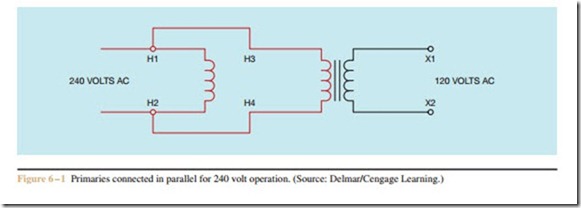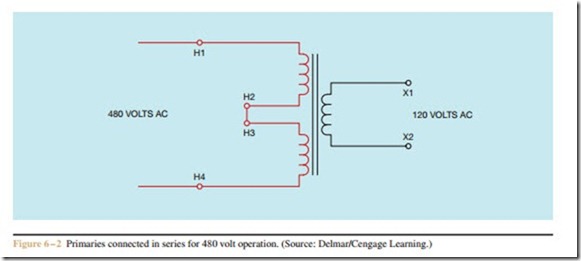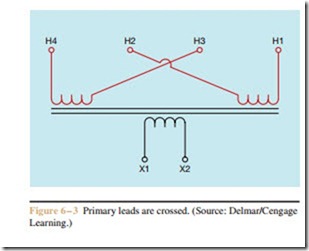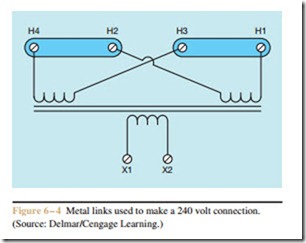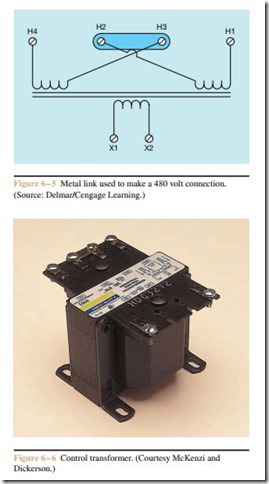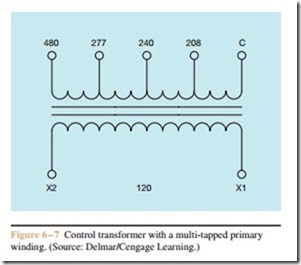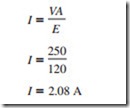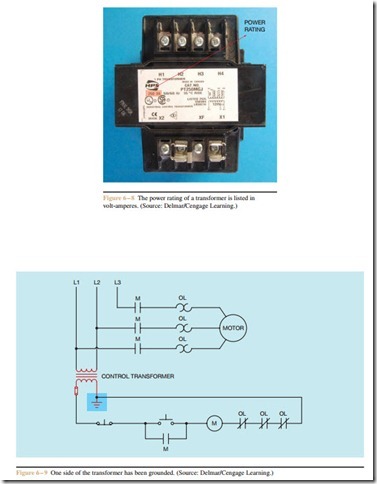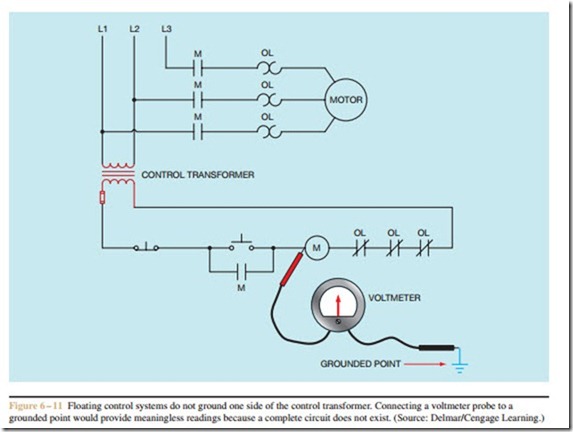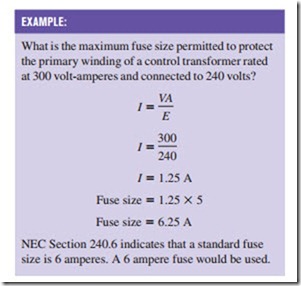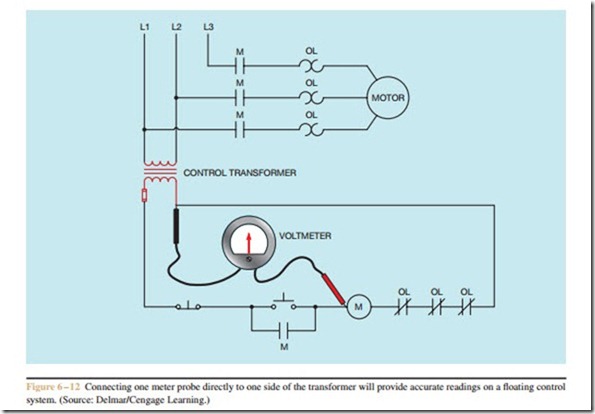Most industrial motors operate on voltages that range from 240 to 480 volts. Magnetic control systems, how- ever, generally operate on 120 volts. A control trans- former is used to step the 240 or 480 volts down to 120 volts to operate the control system. There is really nothing special about a control transformer except that most of them are made with two primary windings and one secondary winding. Each primary winding is rated at 240 volts, and the secondary winding is rated at 120volts. This means there is a turns ratio of 2 : 1 (2 to 1) between each primary winding and the secondary winding. For example, assume that each primary winding contains 200 turns of wire and the secondary winding contains 100 turns. There are two turns of wire in each primary winding for every one turn of wire in the secondary.
One of the primary windings of the control trans- former is labeled H1 and H2. The other primary winding is labeled H3 and H4. The secondary winding is labeled X1 and X2. If the transformer is to be used to step 240 volts down to 120 volts, the two primary windings are connected parallel to each other as shown in Figure 6 – 1. Notice that in Figure 6 – 1 the H1 and
leads are connected together, and the H2 and H4 leads are connected together. Since the voltage applied to each primary winding is the same, the effect is the same as having only one primary winding with 200 turns of wire in it. This means that when the transformer is connected in this manner, the turns ratio is 2 : 1. When 240 volts are connected to the primary winding, the secondary voltage is 120 volts.
If the transformer is to be used to step 480 volts down to 120 volts, the primary windings are connected in series as shown in Figure 6 – 2. With the windings connected in series, the primary winding now has a total of 400 turns of wire, which makes a turns ratio of 4 : 1. When 480 volts is connected to the primary winding, the secondary winding has an output of 120 volts.
Control transformers generally have screw terminals connected to the primary and secondary leads. The H2 and H3 leads are crossed to make connection of the primary winding easier, Figure 6 – 3. For example, if the transformer is to be connected for 240 volt operation, the two primary windings must be connected parallel to each other as shown in Figure 6 – 1. This connection can be made on the transformer by using one metal link to connect leads H1 and H3, and another metal link to connect H2 and H4 (Figure 6 – 4).
If the transformer is to be used for 480 volt operation, the primary windings must be connected in series as shown in Figure 6 – 2. This connection can be made on the control transformer by using a metal link
is indicated in volt-amperes, not watts, because trans- formers generally supply power to operate inductive devices such as the coils of relays and motor starters (Figure 6 – 8). The volt-ampere rating indicates the amount of current the transformer can supply to oper- ate control devices. To determine the maximum output current of a transformer, divide the volt-ampere rating by the secondary voltage. The transformer shown in Figure 6 – 8 has a power rating of 250 volt-amperes. If the secondary voltage is 120 volts, the maximum sec- ondary current would be 2.08 amperes.
to connect H2 and H3 as shown in Figure 6 – 5. A typical control transformer is shown in Figure 6 – 6.
Some control transformers contain a multi-tapped primary instead of two separate windings (Figure 6 – 7). The transformer in this example is designed to step voltages of 480, 277, 240, or 208 down to 120.
Power Rating
The power rating of control transformers generally ranges from 0.75 kilovolt-amperes, or 75 volt-amperes, to 1 kilovolt-ampere, or 1000 volt-ampere. The rating
A control transformer intended to operate a single motor starter may have a rating of 75 to 100 volt- amperes. Transformers intended to supply power to an entire relay cabinet will have much higher ratings, depending on the number of devices and their current requirements.
Grounded and Floating Control Systems
One side of the secondary winding of a control transformer is often grounded (Figure 6 – 9). When this is done, the control system, is referred to as a grounded system. Many industries prefer to ground the control
system, and it is a very common practice. Some techni- cians believe that it is an aid when troubleshooting a problem. Grounding one side of the control trans- former permits one lead of a voltmeter to be connected to any grounded point and the other voltmeter lead to be used to test voltage at various locations throughout the circuit (Figure 6 – 10).
However, it is also a common practice to not ground one side of the control transformer. This is gen- erally referred to as a floating system. If one voltmeter probe were to be connected to a grounded point, the meter reading would be erroneous or meaningless since there is not a complete circuit (Figure 6 – 11). High impedance voltmeters would probably indicate some amount of voltage caused by the capacitance of the ground and induced voltage produced by surrounding magnetic fields. These are generally referred to as ghost voltages. A low impedance meter such as a plunger type voltage tester would indicate no voltage. Accurate voltage measurement can be made in a float control system, however, by connecting one voltmeter probe directly to one side of the control transformer (Figure 6 – 12). Since both grounded and floating control systems are common, both will be illustrated throughout this text.
Transformer Fusing
Control transformers are generally protected by fuses or circuit breakers. Protection can be placed on the primary or secondary side of the transformer, and some industries prefer protection on both sides. NEC Section 430.72(C) lists requirements for the protection of transformers employed in motor control circuits. This section basically states that control transformers that have a primary current of less than 2 amperes shall be protected by an overcurrent device set at not more than 500% of the rated primary current. This large per- centage is necessary because of the high in-rush current associated with transformers. To determine the rated current of the transformer, divide the volt-ampere rat- ing of the transformer by the primary voltage.
NEC Section 430.72(C)(2) states that fuse protection in accordance with 450.3 is permitted also. This section states that primary protection for trans- formers rated 600 volts or less is determined in NEC Table 430.3(B). The table indicates a rating of 300% of the rated current.
The secondary fuse size can also be determined from NEC Table 450.3(B). The table indicates a rating of 167% of the rated secondary current for fuses protecting a transformer secondary with a current of less than 9 amperes. Assuming a control voltage of 120 volts, the rated secondary current of the trans- former in the previous example would be 2.5 amperes (300/120). The fuse size would be:
2.5 X 1.67 = 4.175 A
The nearest standard fuse size listed in 240.6 without going over this value is 3 amperes. The secondary fuse
size can be set at a lower percentage of the rated current because the secondary does not experience the high in-rush current of the primary. Since primary and secondary fuse protection is common throughout in dustry, control circuits presented in this text will illustrate both.
1. What is the operating voltage of most magnetic control systems?
2. How many primary windings do control trans- formers have?
3. How are the primary windings connected when the transformer is to be operated on a 240 volt system?
4. How are the primary windings connected when the transformer is to be operated on a 480 volt system?
5. Why are two of the primary leads crossed on a control transformer?
6. You are an electrician working in an industrial plant. You are building a motor control cabinet that contains six motor starters and six pilot lamps. All control components operate on 120 volts AC. Two of the motor starters have coil currents of 0.1 amperes each and four have coil currents of 0.18 amperes each. The six pilot lamps are rated at 5 watts each. The supply room has control transformers with the following rating (in volt-amperes): 75, 100, 150, 250, 300, and 500. Which of the avail- able control transformers should you choose to supply the power for all the control components in the cabinet? (Choose the smallest size that will supply the power needed.)
